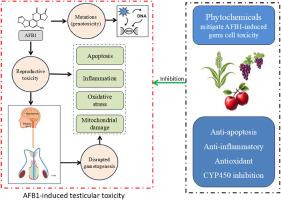黄曲霉毒素b1诱导的男性生殖毒性:人类和动物的生物激活、机制、分子途径和植物化学物质的缓解
IF 2.4
4区 医学
Q2 PHARMACOLOGY & PHARMACY
引用次数: 0
摘要
黄曲霉毒素(AFTs)是真菌毒素的一个主要亚类,被广泛认为是食物系统和环境基质(土壤、水、空气尘埃)中的关键污染物。其中,黄曲霉毒素B1 (AFB1)被认为是毒性和生物活性最高的化合物,具有广泛的有害作用,包括肾毒性、免疫毒性、神经毒性、肝毒性和遗传毒性。越来越多的证据强调了AFB1在损害生殖健康方面的作用,特别强调了AFB1在人类和动物中引起的不孕症。该化合物对生殖器官的结构和生理功能产生不利影响,导致雄性配子发生中断,从而导致生育率下降。这些睾丸毒性对公共卫生、粮食安全和动物生产力构成严重威胁。afb1介导的生殖损伤的分子机制包括凋亡、炎症、自噬、细胞周期失调和氧化应激。近年来,天然衍生的植物化学物质因其在适当剂量下的低毒性和天然的结构基序而成为有希望的对策。这些生物活性化合物具有抗氧化、抗炎和抗凋亡作用,从而减轻afb1诱导的生殖细胞毒性。此外,某些植物化学物质调节AFB1在体内的生物转化和解毒,降低其遗传毒性潜能并促进其排泄。本文综述了afb1在雄性哺乳动物中引起的睾丸毒性,重点介绍了潜在的分子途径和各种植物性药物的保护作用。它进一步描述了这些植物化学物质抗afb1活性的机制基础,引起了人们对它们的共同特性和物种特异性反应的关注。在此,我们确定了当前研究中存在的差距,并提出了优化植物化学干预的未来方向。总的来说,这篇综述强调了植物化学物质通过靶向调节关键信号通路来缓解afb1相关生殖功能障碍的治疗潜力。本文章由计算机程序翻译,如有差异,请以英文原文为准。

Aflatoxin B1-Induced male reproductive Toxicity: Bioactivation, mechanisms, molecular pathways, and Mitigation by phytochemicals in humans and animals
Aflatoxins (AFTs) represent a major subclass of mycotoxins that are widely recognized as critical contaminants in both food systems and environmental matrices (soil, water, air dust). Among them, aflatoxin B1 (AFB1) is identified as the most toxic and biologically active compound, exhibiting a broad spectrum of deleterious effects, including nephrotoxicity, immunotoxicity, neurotoxicity, hepatotoxicity and genotoxicity. Increasing evidence has highlighted the role of AFB1 in impairing reproductive health, with a particular emphasis on AFB1-induced infertility in both humans and animals. The compound adversely affects the architecture and physiological functions of reproductive organs, leading to disrupted gametogenesis in males and consequent reductions in fertility rates. These testicular toxicities pose serious threats to public health, food security, and animal productivity. The molecular mechanisms implicated in AFB1-mediated reproductive damage include apoptosis, inflammation, autophagy, cell cycle dysregulation, and oxidative stress. Recently, naturally derived phytochemicals have emerged as promising countermeasures due to their low toxicity at appropriate doses and natural structural motifs. These bioactive compounds exert antioxidant, anti-inflammatory, and anti-apoptotic effects, thereby mitigating AFB1-induced germ cell toxicity. Additionally, certain phytochemicals modulate the biotransformation and detoxification of AFB1 in vivo, reducing its genotoxic potential and facilitating its excretion. This review provides a comprehensive analysis of AFB1-induced testicular toxicity in male mammals, with a focus on the underlying molecular pathways and protective roles of various plant-based agents. It further delineates the mechanistic basis for the anti-AFB1 activity of these phytochemicals, drawing attention to their shared properties and species-specific responses. Here, we identify existing gaps in current research and propose future directions to optimize phytochemical interventions. Overall, this review underscores the therapeutic potential of phytochemicals in alleviating AFB1-associated reproductive dysfunction through targeted modulation of critical signaling pathways.
求助全文
通过发布文献求助,成功后即可免费获取论文全文。
去求助
来源期刊

Toxicon
医学-毒理学
CiteScore
4.80
自引率
10.70%
发文量
358
审稿时长
68 days
期刊介绍:
Toxicon has an open access mirror Toxicon: X, sharing the same aims and scope, editorial team, submission system and rigorous peer review. An introductory offer Toxicon: X - full waiver of the Open Access fee.
Toxicon''s "aims and scope" are to publish:
-articles containing the results of original research on problems related to toxins derived from animals, plants and microorganisms
-papers on novel findings related to the chemical, pharmacological, toxicological, and immunological properties of natural toxins
-molecular biological studies of toxins and other genes from poisonous and venomous organisms that advance understanding of the role or function of toxins
-clinical observations on poisoning and envenoming where a new therapeutic principle has been proposed or a decidedly superior clinical result has been obtained.
-material on the use of toxins as tools in studying biological processes and material on subjects related to venom and antivenom problems.
-articles on the translational application of toxins, for example as drugs and insecticides
-epidemiological studies on envenoming or poisoning, so long as they highlight a previously unrecognised medical problem or provide insight into the prevention or medical treatment of envenoming or poisoning. Retrospective surveys of hospital records, especially those lacking species identification, will not be considered for publication. Properly designed prospective community-based surveys are strongly encouraged.
-articles describing well-known activities of venoms, such as antibacterial, anticancer, and analgesic activities of arachnid venoms, without any attempt to define the mechanism of action or purify the active component, will not be considered for publication in Toxicon.
-review articles on problems related to toxinology.
To encourage the exchange of ideas, sections of the journal may be devoted to Short Communications, Letters to the Editor and activities of the affiliated societies.
 求助内容:
求助内容: 应助结果提醒方式:
应助结果提醒方式:


